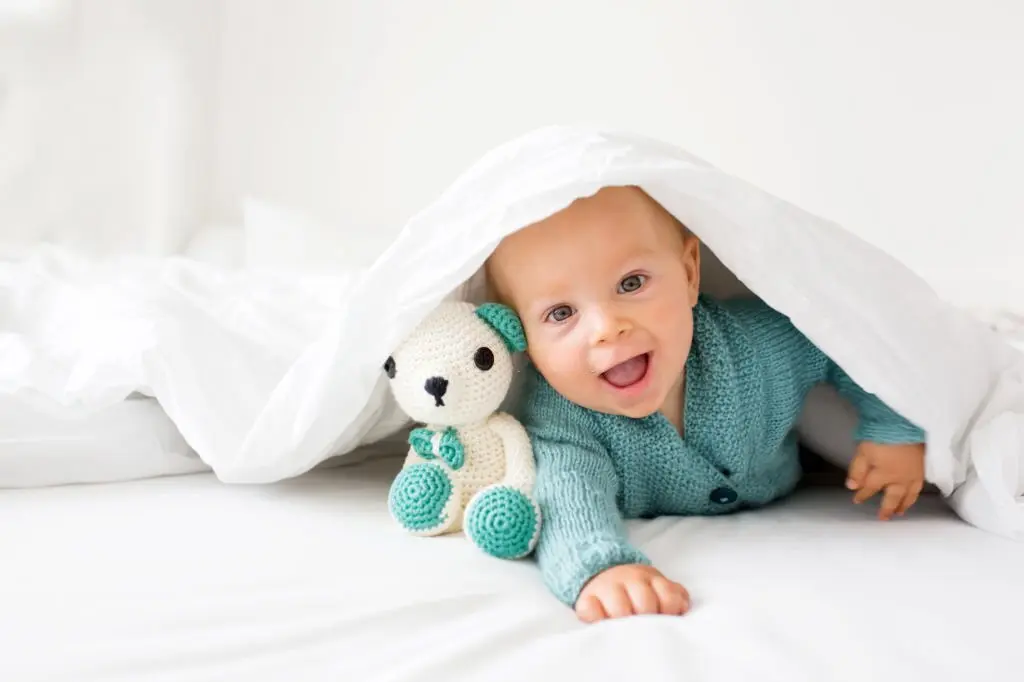How to Choose the Right Baby Bedding

Introduction to how to choose the right baby bedding
Becoming a parent marks the beginning of a remarkable journey filled with unending joy, remarkable moments, and equally important decisions.
One significant decision is selecting the right baby bedding for your little one’s comfort and safety. This process might seem daunting initially but don’t worry. With a little guidance and understanding, you’ll find it’s more manageable than it appears.
Importance of choosing the right baby bedding

The right baby bedding is paramount for many reasons. To begin with, your newborn will spend most of their time sleeping.
This emphasizes the need for the perfect bedding set, which ensures not only their comfort but also the safety of your little one.
A well-chosen bedding set can promote better sleep for your baby, thus contributing to their overall health and development. Moreover, the right baby bedding reduces risks associated with poor quality or ill-fitting bedding, such as suffocation, allergies, or overheating.
Understanding the basics
Before you embark on the journey to find the perfect baby bedding, let’s break down what baby bedding includes. This understanding will give you the information you need to make a sound choice.
Types of baby bedding
Crib sheets
Crib sheets are bed linens that tightly cover the mattress in your baby’s crib. They are essentially the surface your baby will sleep on. These sheets must fit snugly around the mattress without loose corners or extra fabric. Loose sheets can pose a safety hazard as they might lead to suffocation.
Baby blankets
Baby blankets play a significant role in keeping your baby cozy and warm. Remember that newborns can’t regulate their body temperature the way adults do, so a well-selected baby blanket can provide the warmth they need without causing overheating.
Crib skirts
While crib skirts may not play a functional role in your baby’s sleep, they certainly add an aesthetic touch to your baby’s crib. Besides the decorative aspect, they also hide any storage under the crib, thus keeping the overall look neat and tidy.
Considerations while choosing baby bedding
When it comes to choosing the right baby bedding, there are several factors to take into consideration. These factors will ensure you select a bedding set that is aesthetically pleasing, practical, and safe for your baby.
Material
The material of your baby’s bedding is one of the first things you should consider. A baby’s skin is far more sensitive than an adult’s, so it’s crucial to opt for materials that are hypoallergenic and soft. Organic cotton is a popular choice as it’s not only gentle on the skin but also breathable, reducing the chance of overheating.
Size
Size is another critical aspect to consider. The bedding you choose should fit your baby’s crib perfectly. Bedding that’s too loose or too small can pose a safety hazard, as it might come loose and risk suffocation.
Comfort
Remember, your baby will be spending a lot of time in their crib, so comfort is key. Opt for bedding that provides enough cushioning and promotes sound sleep. Bedding with temperature-regulating properties can be a great choice, ensuring your baby stays comfortable throughout different seasons.
Safety
Safety is undoubtedly the most important consideration when choosing baby bedding. Avoid bedding that comes with loose parts or embellishments that your baby could accidentally ingest. Keep the crib environment as simple as possible, and always prioritize safety over style.
Ease of cleaning
Babies are adorable, but they can also be quite messy! Choose materials that are machine-washable and durable enough to withstand frequent washing.
Additional tips on how to choose the right baby bedding
In addition to the considerations above, it’s important to remember a few additional tips. First, avoid including pillows and plush toys in your baby’s crib, as they can pose a suffocation risk.
Also, having multiple sets of bedding on hand is always a good idea, so you’re never left in a bind when one set needs washing.
Conclusion on how to choose the right baby bedding
Choosing the right baby bedding goes beyond aesthetics. It’s a matter of your child’s comfort and safety. It may seem challenging, but with the right information and guidance, it doesn’t have to be overwhelming.
Hopefully, this article has provided a roadmap to make your decision process smoother. Remember, the key to making the right choice is understanding what’s best for your baby’s comfort, safety, and convenience. Happy parenting!
Also Read:
- What Type of Bedding is Best for a Baby
- When Should I Start Using Baby Bedding
- How to Make Baby More Comfortable in Crib
- How to Prevent Baby From Hitting Head on Crib
- How do You Turn a Closet into a Nursery
FAQs on how to choose the right baby bedding
Can I use regular detergent to wash baby bedding?
While it might be tempting to use regular detergent for convenience, it’s recommended to use a gentle, baby-friendly detergent.
These are specially formulated to be gentle on your baby’s sensitive skin and reduce the risk of skin irritations or allergies.
How often should I change the baby’s bedding?
The frequency of changing the baby’s bedding depends on your baby’s habits and any unforeseen accidents.
However, as a general guideline, changing the bedding once a week is sufficient. If there are spillages or accidents, immediate change is necessary.
Should I get a waterproof crib sheet?
Yes, a waterproof crib sheet can be a great investment. They serve to protect the mattress from diaper leaks or spit-ups, saving you a lot of cleaning effort in the long run.
What material is best for baby bedding?
Organic cotton is highly recommended for baby bedding due to its softness, breathability, and hypoallergenic properties.
It’s gentle on your baby’s skin and is less likely to cause any allergic reactions or skin irritations.
Is it necessary to buy crib skirts?
Crib skirts are not a necessity for your baby’s comfort or safety. They serve more of a decorative role, giving a finished look to your baby’s crib.
If you appreciate their aesthetic value and want to hide under-crib storage, crib skirts could be a good addition to your baby’s bedding set.
How many sets of sheets should I have for my baby?
It’s recommended to have at least 2-3 sets of crib sheets for your baby. This allows you to have a fresh set available when one is in the wash.
If your baby tends to have frequent spit-ups or diaper leaks, you might want to consider having a few extra sets on hand.
How many sets of sheets should I have for my baby?
It’s recommended to have at least 2-3 sets of crib sheets for your baby. This allows you to have a fresh set available when one is in the wash.
If your baby tends to have frequent spit-ups or diaper leaks, you might want to consider having a few extra sets on hand.
How often do you change baby bedding?
Generally, it’s a good idea to change baby bedding once a week under normal circumstances.
However, if there’s a diaper leak, spit-up, or any other mess, you should change the bedding immediately to ensure your baby’s sleeping area is clean and sanitary.
How many blankets should a baby have?
The number of blankets a baby should have can depend on the climate and temperature of your home. Typically, one to two blankets should be sufficient.
However, for newborns and young infants, it’s safer to maintain a warm room temperature and dress the baby appropriately rather than using blankets due to the risk of SIDS (Sudden Infant Death Syndrome) associated with loose bedding.
What type of bedding is best for babies?
When it comes to choosing the best type of bedding for babies, safety, and comfort should be the main considerations. Fitted crib sheets made from soft, breathable materials like organic cotton are ideal.
The bedding should fit the crib snugly and not have any loose parts or embellishments. As for blankets, avoid using them for younger babies. Instead, consider wearable blankets or sleep sacks that don’t pose a risk of suffocation.
Remember, each baby is unique, and what works best for one might not necessarily be the best for another. Always observe your baby’s comfort and adjust accordingly.
How do you set up baby bedding?
Setting up baby bedding involves a few steps:
Step 1: Start with a firm and snug-fitting mattress. The mattress should fit the crib without leaving any gaps on the sides.
Step 2: Over the mattress, place a waterproof mattress protector to safeguard against diaper leaks or spit-ups.
Step 3: Cover the mattress with a fitted crib sheet, ensuring it fits securely. There should be no loose fabric or corners that could pose a suffocation hazard.
Step 4: Remember, the crib should be kept relatively bare to keep your baby safe. This means no pillows, blankets, or stuffed toys that could potentially cause suffocation.
Step 5: Instead of a blanket, consider using a baby sleep sack or wearable blanket to keep your baby warm.
At what age can a baby have a pillow and duvet?
According to the American Academy of Pediatrics (AAP), pillows, duvets, or any loose bedding should be avoided in a baby’s sleep environment until they are at least 12 months old to reduce the risk of Sudden Infant Death Syndrome (SIDS).
Even after this age, parents should opt for thin, firm pillows rather than fluffy ones and ensure that the duvet is lightweight and does not overly cover the baby.
How often do you change baby bedding?
As a general rule, baby bedding should be changed once a week or more frequently if the baby spits up, there’s a diaper leak, or any other mess occurs.
It’s important to keep the sleeping area clean and sanitary to maintain your baby’s health.
How do you cover a newborn at night?
The safest way to keep a newborn warm at night is not with loose blankets but with appropriate clothing and room temperature.
Dress your baby in layers, and maintain a room temperature that is comfortable for a lightly clothed adult (about 68-72 degrees Fahrenheit).
If additional warmth is needed, consider a wearable blanket or sleep sack specifically designed for infants. These are safer than loose blankets that could potentially cover a baby’s face and interfere with their breathing.
